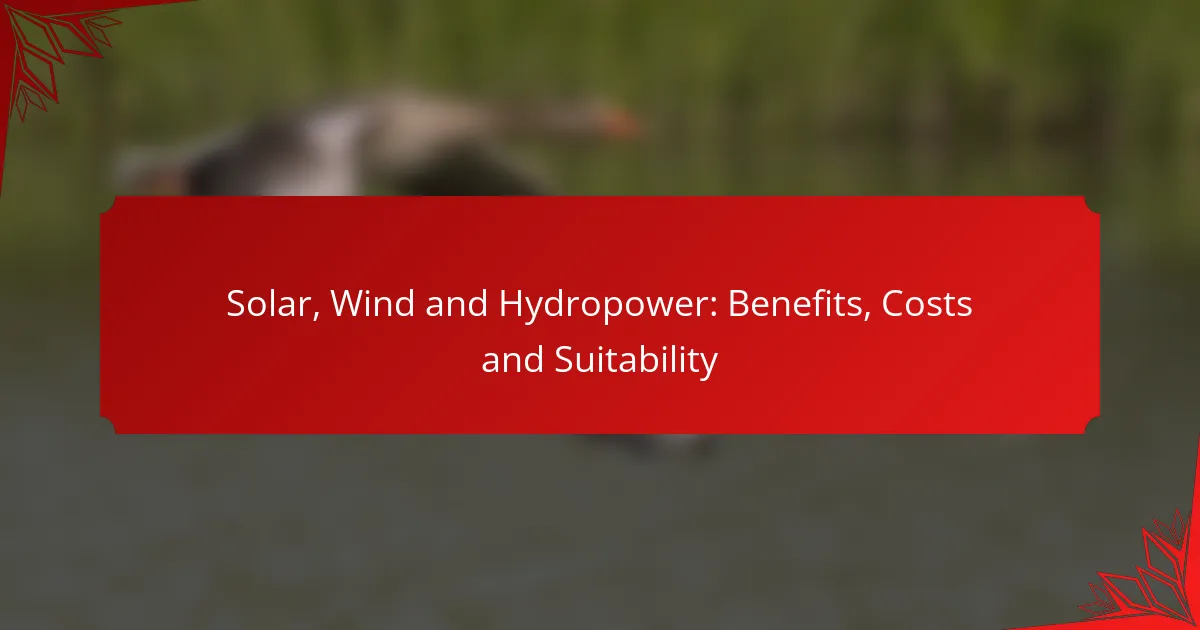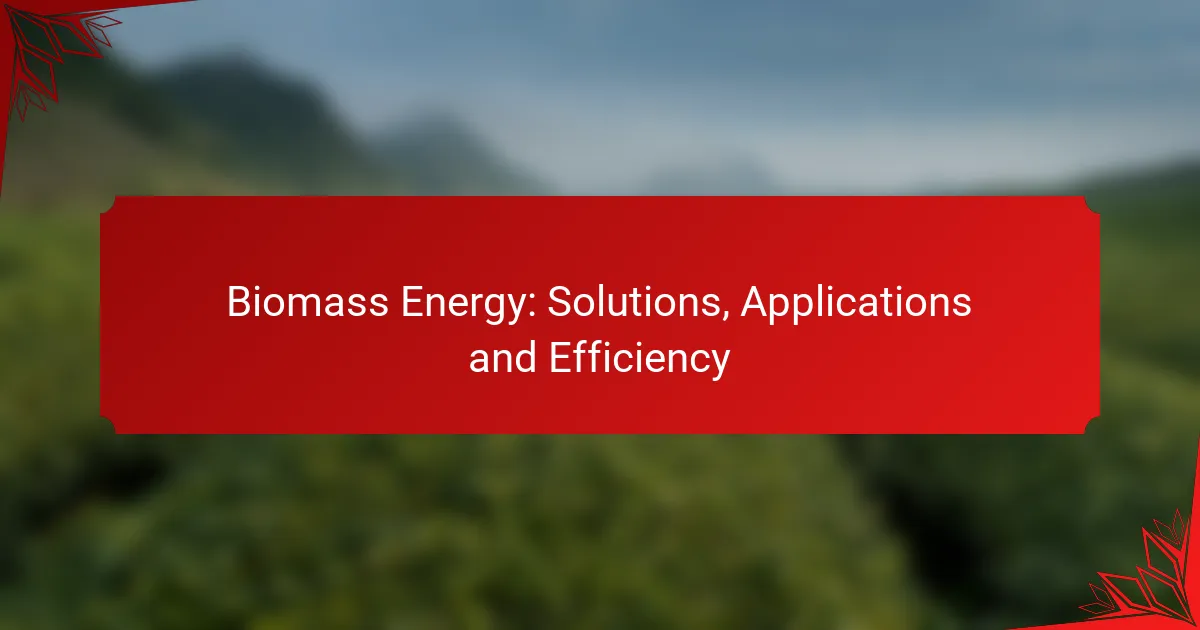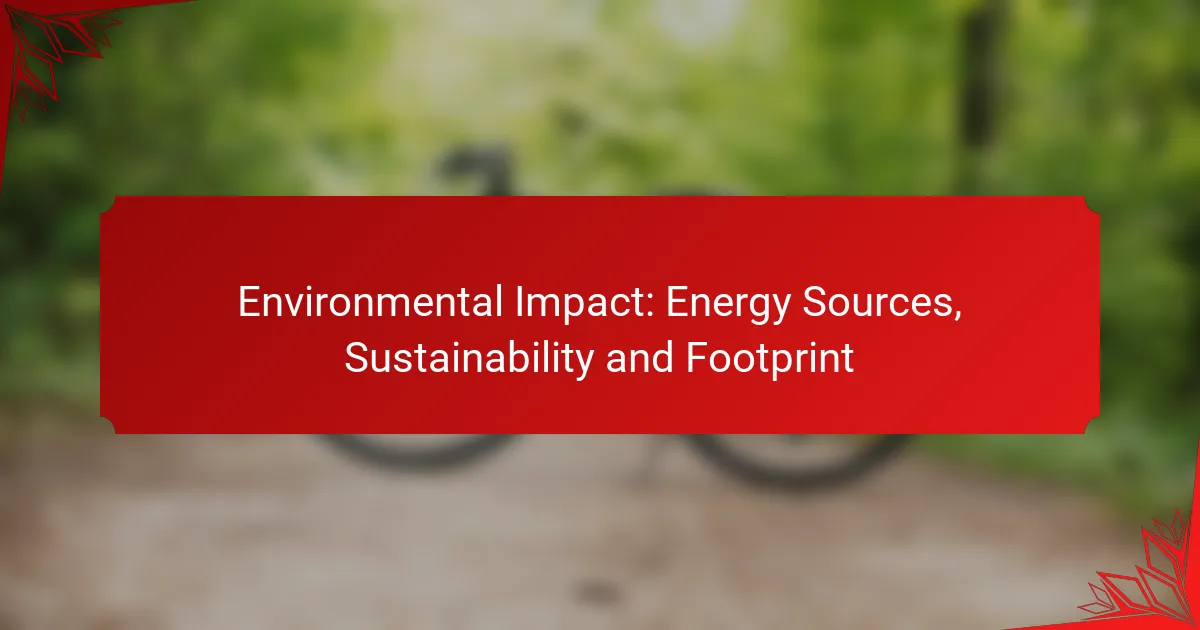Solar, wind, and hydropower are pivotal renewable energy sources that provide substantial benefits such as lower environmental impact, cost savings, and energy independence. However, the costs and suitability of these technologies can vary greatly depending on location and specific conditions, making it essential to assess each option carefully for optimal implementation.
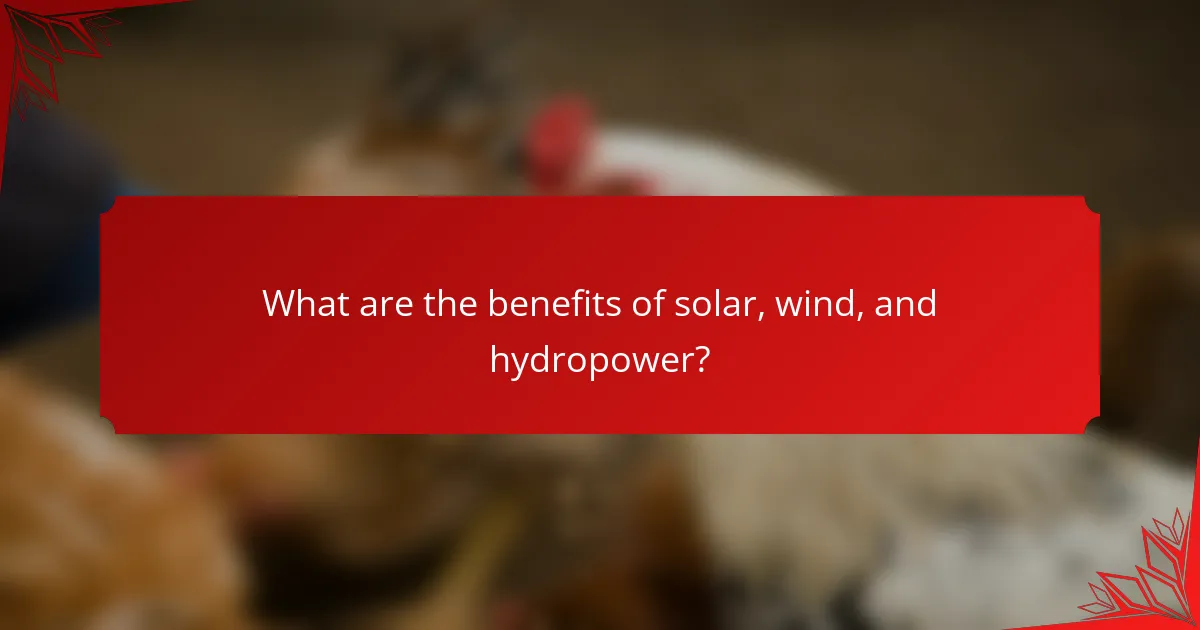
What are the benefits of solar, wind, and hydropower?
Solar, wind, and hydropower offer significant advantages, including reduced environmental impact, long-term cost savings, enhanced energy independence, and the creation of jobs in renewable energy sectors. These benefits make them attractive alternatives to fossil fuels.
Environmental sustainability
Solar, wind, and hydropower are key players in promoting environmental sustainability. They produce little to no greenhouse gas emissions during operation, significantly reducing air pollution compared to traditional energy sources. This transition helps combat climate change and preserves natural ecosystems.
Additionally, these renewable sources utilize natural processes, such as sunlight, wind, and flowing water, minimizing resource depletion. For instance, solar panels convert sunlight into electricity without consuming water, unlike fossil fuel plants that require significant water for cooling.
Cost savings over time
Investing in solar, wind, and hydropower can lead to substantial cost savings in the long run. Although the initial installation costs may be higher, these renewable energy sources typically have lower operational and maintenance expenses. Over time, users can benefit from reduced utility bills and potential tax incentives.
For example, solar panel systems can pay for themselves within a few years through savings on electricity costs. Many homeowners report savings of 20-30% on their energy bills after installation, depending on local energy prices and available incentives.
Energy independence
Utilizing solar, wind, and hydropower enhances energy independence for countries and communities. By harnessing local renewable resources, nations can reduce reliance on imported fossil fuels, which can be subject to price volatility and geopolitical tensions. This shift can lead to greater energy security.
For instance, countries investing in large-scale wind farms or solar arrays can generate a significant portion of their energy needs domestically. This not only stabilizes energy prices but also fosters local economies by keeping energy dollars within the community.
Job creation in renewable sectors
The renewable energy sector is a significant source of job creation. As the demand for solar, wind, and hydropower increases, so does the need for skilled workers in installation, maintenance, and manufacturing. This growth can lead to thousands of new jobs in various regions.
According to industry reports, jobs in renewable energy have been growing at a faster rate than those in fossil fuel industries. For example, solar and wind jobs can range from technicians to engineers, providing diverse opportunities for employment and career advancement in a rapidly evolving field.
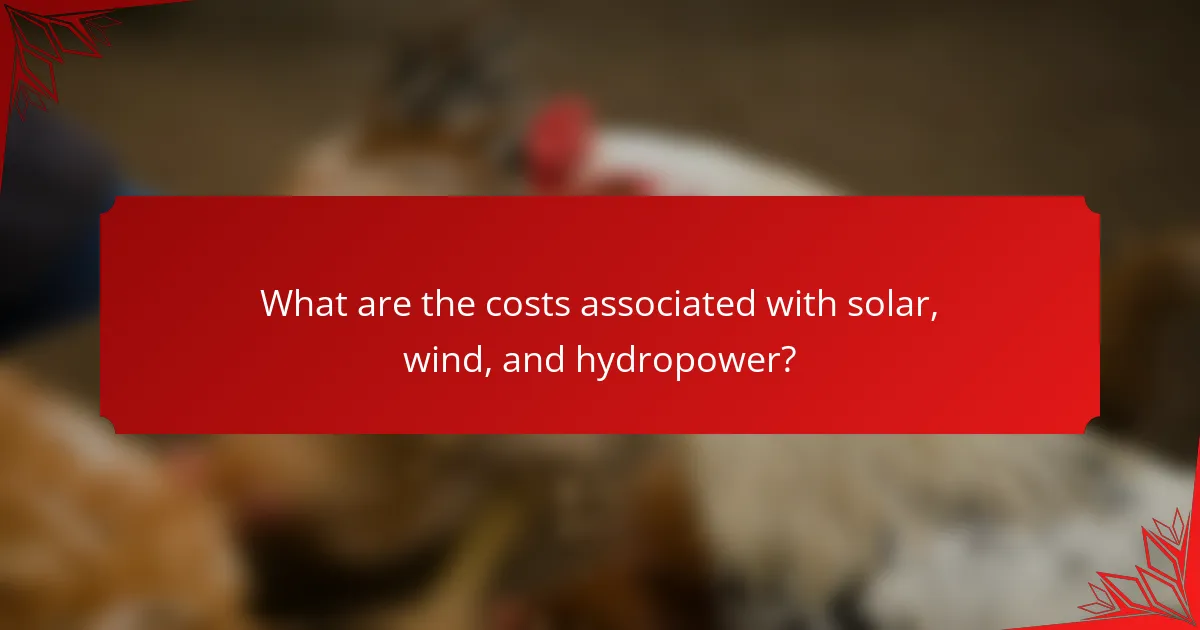
What are the costs associated with solar, wind, and hydropower?
The costs associated with solar, wind, and hydropower vary significantly based on factors like location, technology, and scale. Understanding these costs is crucial for evaluating the feasibility and long-term savings of each renewable energy source.
Initial installation costs
Initial installation costs for solar, wind, and hydropower can differ widely. For solar panels, costs typically range from several thousand to tens of thousands of USD, depending on system size and installation complexity. Wind turbines can cost from tens of thousands to millions of USD, influenced by turbine size and site conditions.
Hydropower installations can be particularly expensive, often requiring hundreds of thousands to millions of USD due to infrastructure needs. It’s essential to consider local regulations and potential site-specific challenges that may affect these costs.
Maintenance and operational expenses
Maintenance and operational expenses for renewable energy systems are generally lower than for fossil fuels. Solar systems typically require minimal maintenance, often costing a few hundred USD annually for cleaning and inspections. Wind turbines may incur higher costs, ranging from several hundred to a few thousand USD per year, depending on the turbine’s size and location.
Hydropower systems can have variable maintenance costs, often influenced by the complexity of the facility. Regular inspections and repairs can lead to annual expenses in the low thousands of USD, but these costs are often offset by the long operational lifespan of hydropower plants.
Long-term financial incentives
Long-term financial incentives play a significant role in the overall costs of solar, wind, and hydropower. Many governments offer tax credits, rebates, or grants to encourage renewable energy adoption. For instance, in the United States, the federal solar tax credit allows homeowners to deduct a substantial percentage of installation costs from their federal taxes.
Additionally, power purchase agreements (PPAs) and feed-in tariffs can provide stable revenue streams for wind and hydropower projects. These incentives can significantly reduce the effective cost of energy over time, making renewable sources more competitive with traditional energy options.
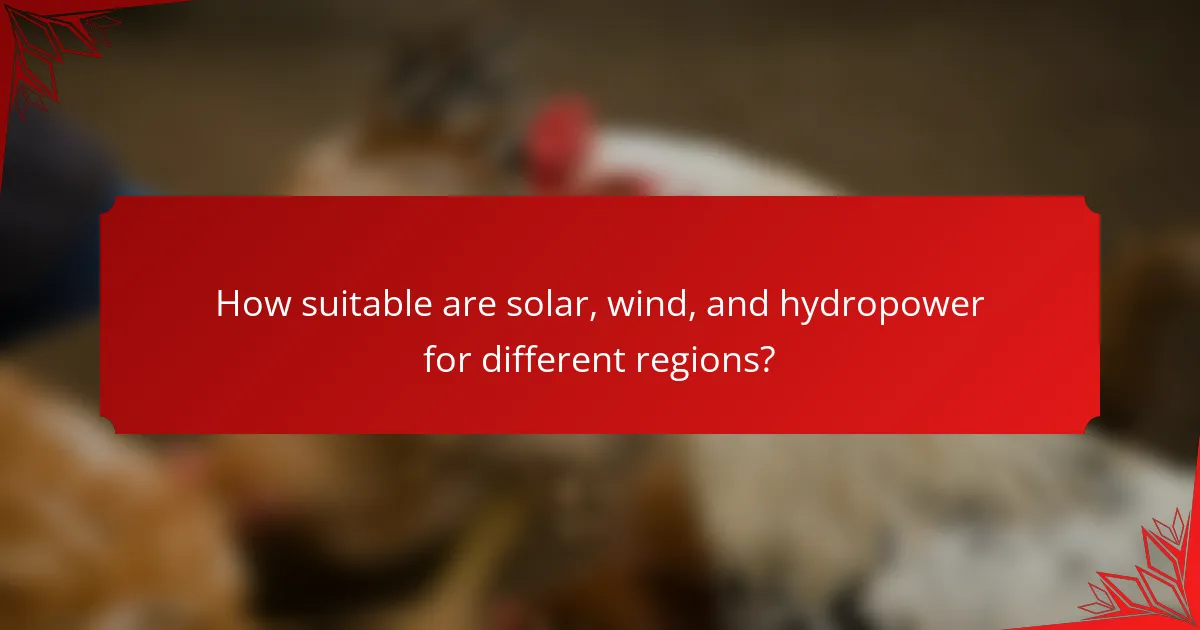
How suitable are solar, wind, and hydropower for different regions?
Solar, wind, and hydropower are highly dependent on geographic and climatic conditions, making their suitability vary significantly across different regions. Understanding these factors can help in selecting the most effective renewable energy source for a specific area.
Solar suitability in sunny climates
Solar energy is most effective in regions with abundant sunshine, such as the southwestern United States, parts of Australia, and southern Europe. These areas can achieve high solar panel efficiency, often exceeding 20% during peak sunlight hours.
When considering solar installations, factors like roof orientation, shading from nearby structures, and local regulations play a crucial role. For optimal performance, solar panels should ideally face south in the Northern Hemisphere and north in the Southern Hemisphere.
Wind power potential in coastal areas
Coastal regions typically experience stronger and more consistent winds, making them ideal for wind energy generation. Areas like the eastern coast of the United States and parts of the North Sea in Europe have significant wind power potential.
When evaluating wind power, consider the average wind speeds, which should ideally be above 5 meters per second for effective turbine operation. Additionally, local zoning laws and environmental impact assessments are essential steps before installation.
Hydropower feasibility in river-rich regions
Hydropower is most viable in regions with abundant rivers and significant elevation changes, such as the Pacific Northwest in the United States or the Alps in Europe. These areas can harness river flow to generate substantial energy, often providing a stable power supply.
Key considerations for hydropower include the river’s flow rate, seasonal variations, and environmental regulations. Projects often require extensive permits and assessments to ensure minimal ecological disruption, making thorough planning essential.
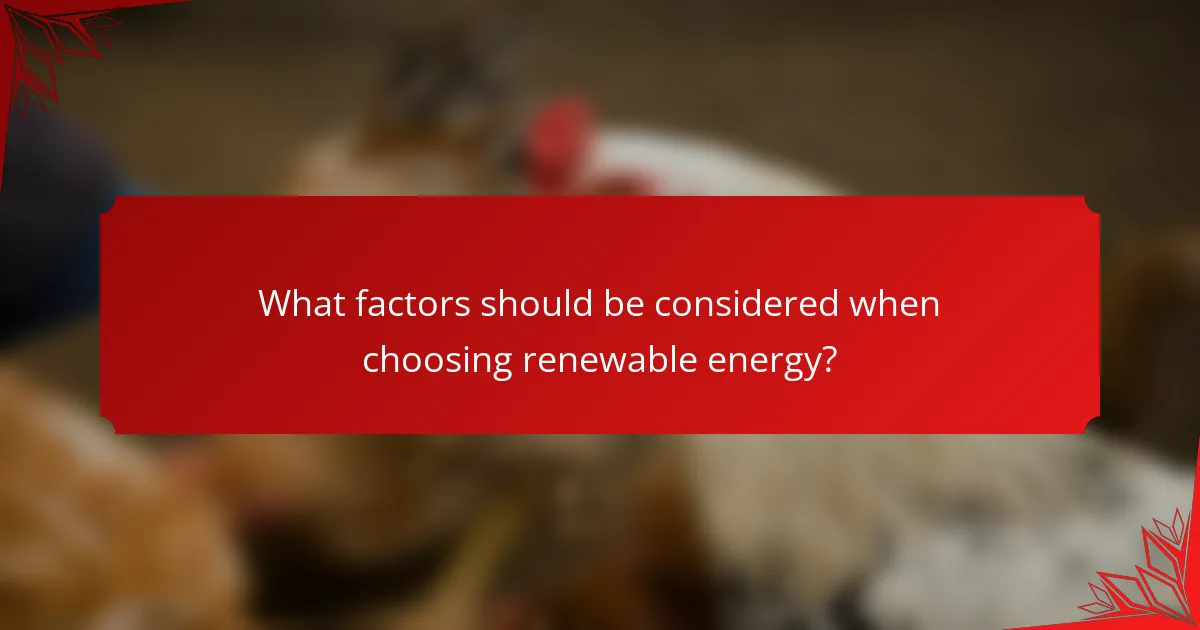
What factors should be considered when choosing renewable energy?
When selecting renewable energy sources, it’s essential to evaluate local climate, energy needs, and available government incentives. These factors significantly influence the feasibility, cost, and efficiency of solar, wind, and hydropower systems.
Local climate and geography
The local climate and geography play a crucial role in determining the suitability of renewable energy sources. For instance, solar energy is most effective in regions with high sunlight exposure, while wind energy thrives in areas with consistent wind patterns. Hydropower requires access to flowing water sources, making it ideal for locations near rivers or waterfalls.
Considerations such as seasonal variations and extreme weather conditions can also impact energy generation. For example, areas prone to heavy snowfall may face challenges in maintaining solar panels, while regions with frequent storms might need to assess the durability of wind turbines.
Energy needs and consumption patterns
Understanding energy needs and consumption patterns is vital for selecting the right renewable energy source. Analyze peak usage times and overall demand to determine the capacity required from your renewable system. For example, if energy consumption is highest during sunny days, solar power may be a suitable choice.
Additionally, consider the scale of energy production needed. Residential systems may require less capacity than commercial or industrial setups. A thorough assessment of current and future energy needs can help in making informed decisions about system size and type.
Government incentives and regulations
Government incentives and regulations can significantly affect the financial viability of renewable energy projects. Many countries offer tax credits, rebates, or grants to encourage the adoption of solar, wind, and hydropower systems. Research local policies to identify available support that can reduce upfront costs.
Stay informed about regulations that may impact installation and operation, such as zoning laws or environmental assessments. Compliance with these regulations is essential to avoid fines and ensure the successful implementation of renewable energy solutions.
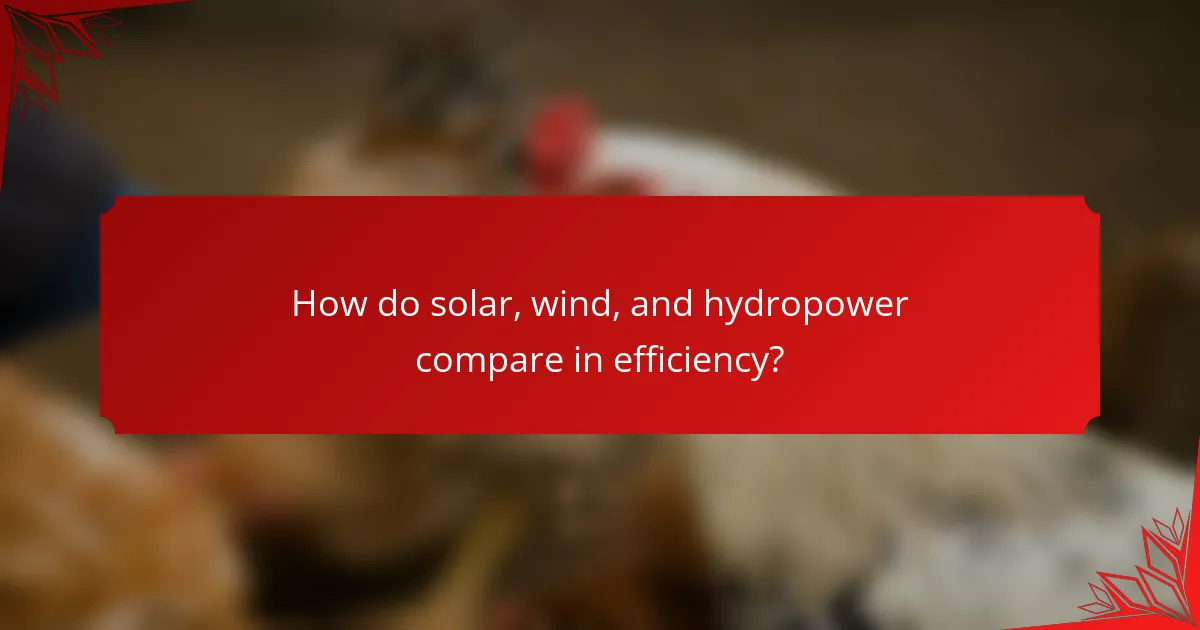
How do solar, wind, and hydropower compare in efficiency?
Solar, wind, and hydropower each have distinct efficiency characteristics that influence their suitability for energy generation. Generally, hydropower tends to have the highest efficiency rates, while solar and wind vary based on technology and environmental conditions.
Efficiency rates of solar panels
Solar panels typically convert around 15-22% of sunlight into electricity, depending on the technology used. High-efficiency models can reach up to 23-25%, but these are often more expensive. Factors such as installation angle, shading, and geographic location can significantly impact overall performance.
To maximize efficiency, consider using solar panels in areas with high solar insolation, such as southern regions of the United States or Mediterranean climates. Regular maintenance, including cleaning and monitoring, can also help maintain optimal performance.
Wind turbine performance metrics
Wind turbines generally achieve efficiency rates between 35-45%, with some advanced models reaching up to 50%. The efficiency largely depends on wind speed, turbine design, and location. Areas with consistent, strong winds are ideal for wind energy generation.
When assessing wind turbine performance, consider the capacity factor, which indicates how often a turbine operates at full power. A capacity factor of 30-50% is common for onshore turbines, while offshore turbines can achieve higher factors due to stronger winds.
Hydropower generation capacity
Hydropower systems can achieve efficiency rates of 70-90%, making them one of the most efficient renewable energy sources. The efficiency depends on the type of hydropower system, such as run-of-river, reservoir, or pumped storage. Each type has its own operational characteristics and suitability for different environments.
When evaluating hydropower options, consider factors like water flow, elevation changes, and environmental impact. Regulatory frameworks often govern the development of hydropower projects, so understanding local laws and permits is essential for successful implementation.
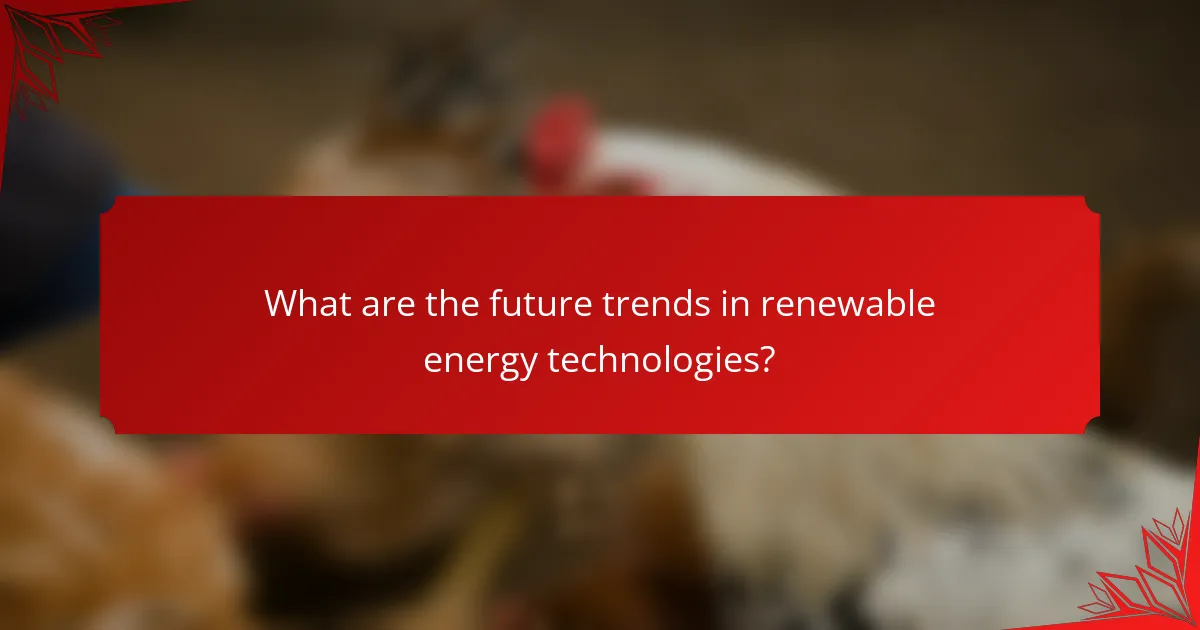
What are the future trends in renewable energy technologies?
The future of renewable energy technologies is characterized by increasing efficiency, decreasing costs, and greater integration into existing energy systems. Innovations in solar, wind, and hydropower are driving these trends, making clean energy more accessible and practical for various applications.
Advancements in Solar Technology
Solar technology is evolving rapidly, with improvements in photovoltaic (PV) efficiency and energy storage solutions. New materials, such as perovskite solar cells, promise higher efficiency rates at lower costs, potentially revolutionizing the solar market.
Additionally, solar energy systems are increasingly being paired with battery storage to provide reliable power even when sunlight is not available. This combination allows for greater energy independence and can help stabilize energy grids.
Growth of Wind Energy
Wind energy is seeing significant advancements, particularly in turbine design and size. Modern turbines are larger and more efficient, capable of generating power even in low-wind conditions. Offshore wind farms are becoming more common, leveraging stronger and more consistent winds found at sea.
The cost of wind energy has decreased substantially over the past decade, making it one of the most competitive forms of energy generation. Countries like Denmark and Germany are leading the way in integrating wind power into their energy portfolios.
Hydropower Innovations
Hydropower remains a crucial player in renewable energy, with innovations focusing on small-scale and run-of-river projects. These systems minimize environmental impact while providing reliable energy generation, making hydropower more adaptable to various locations.
Emerging technologies, such as hydrokinetic energy systems that harness energy from flowing water without the need for large dams, are gaining traction. This approach can help expand hydropower’s reach while preserving ecosystems.
